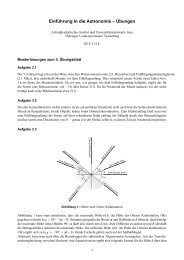Celestial Mechanics — Exercises - Astrophysikalisches Institut und ...
Celestial Mechanics — Exercises - Astrophysikalisches Institut und ...
Celestial Mechanics — Exercises - Astrophysikalisches Institut und ...
You also want an ePaper? Increase the reach of your titles
YUMPU automatically turns print PDFs into web optimized ePapers that Google loves.
Solutions to Unit 7<br />
Problem 7.1<br />
The semilatus rectum is defined through<br />
<strong>Celestial</strong> <strong>Mechanics</strong> <strong>—</strong> <strong>Exercises</strong><br />
A. V. Krivov & C. Schüppler<br />
<strong>Astrophysikalisches</strong> <strong>Institut</strong> <strong>und</strong> Universitätssternwarte Jena<br />
2013-01-09<br />
and accordingly, its first derivative with respect to time through<br />
Using the known Gauss perturbation equations for ˙a and ˙e,<br />
we find<br />
Problem 7.2<br />
p = a(1 − e 2 ), (1)<br />
˙p = ˙a(1 − e 2 ) − 2ae ˙e = ˙a p<br />
− 2ae ˙e. (2)<br />
a<br />
˙a = 2a 2 esinθ S ′ + (1 + ecosθ)T ′ , (3)<br />
˙e = psinθ S ′ + p · (cosθ + cosE)T ′ , (4)<br />
˙p = 2ap(1 − ecosE)T ′ = 2prT ′ . (5)<br />
Since the orbital motion is assumed to be circular, we can neglect the radial part of the drag force, S, and<br />
the Gauss perturbation equation for the semimajor axis reduces to<br />
where<br />
and the tangential part of the specific drag force, T , is given by<br />
Therefore,<br />
˙a = 2a 2 T ′ , (6)<br />
T ′ = T<br />
κ √ , (7)<br />
p<br />
T = ¨x = − Cdσρ ˙x 2<br />
. (8)<br />
2m<br />
˙a = −a 2Cdσρ ˙x 2<br />
mκ √ , (9)<br />
a<br />
where we used the fact that p = a for e = 0. In addition, we know that the velocity ˙x equals the Keplerian<br />
velocity:<br />
We obtain<br />
˙a = − Cdσρκ √ a<br />
m<br />
˙x = κ √ a . (10)<br />
= − Cdσρ √ GM⊕a<br />
m<br />
. (11)<br />
1
We know that a = 340km+6373km ≈ 7× 10 8 cm, ρ ≈ 10 −14 g cm −3 , and κ 2 = GM⊕ = 4×10 20 cm 3 s −2 ,<br />
and we can estimate Cd ∼ 1, σ ∼ 50 × 50m 2 ≈ 3 × 10 7 cm 2 , and m ∼ 400t ≈ 4 × 10 8 g. (Don’t worry if<br />
you took, say, σ = 1000m 2 and m = 100t <strong>—</strong> it’s fine for a rough estimate.) Substituting the numbers<br />
into Eq. (11), we find<br />
˙a ≈ −4 × 10 −1 cm s −1 ,<br />
which translates to an altitude loss of roughly 400 meters per day or about 10 kilometers per month.<br />
Figure 1 shows the real evolution of the ISS’s altitude, with the height loss (between the reboosts) being<br />
consistent with our estimate.<br />
Figure 1: “ This plot shows the orbital height of the ISS over one year. Clearly visible are the re-boosts<br />
which suddenly increase the height, and the gradual decay in between. The height is averaged over one<br />
orbit, and the gradual decrease is caused by atmospheric drag. As can be seen from the plot, the rate<br />
of descent is not constant and this variation is caused by changes in the density of the tenuous outer<br />
atmosphere due mainly to solar activity. ” (Source: www.heavens-above.com, 2011-12-07)<br />
From our estimate, it follows that if the air density were by two orders of magnitude higher (ρ ∼<br />
10 −12 g cm −3 ), the loss rate would be on order of h<strong>und</strong>reds of kilometers per month <strong>—</strong> comparable<br />
with the altitude itself. Obviously, space flight at atmospheric layers that thick would no longer be possible.<br />
Figure 2 shows the output of a commonly used average model for Earth’s atmosphere (Source:<br />
http://modelweb.gsfc.nasa.gov/). The critical density of ρ ≈ 10 −12 g cm −3 discussed above<br />
is reached at an altitude of ≈ 170km. There are indeed no satellites flying closer to the Earth surface<br />
than that.<br />
2<br />
Density [g/cm 3 ]<br />
0.01<br />
1e-04<br />
1e-06<br />
1e-08<br />
1e-10<br />
1e-12<br />
1e-14<br />
1e-16<br />
Atmospheric mass density<br />
1e-18<br />
0 200 400 600 800 1000<br />
Altitude [km]<br />
Figure 2: Average mass density of the atmosphere against altitude.




